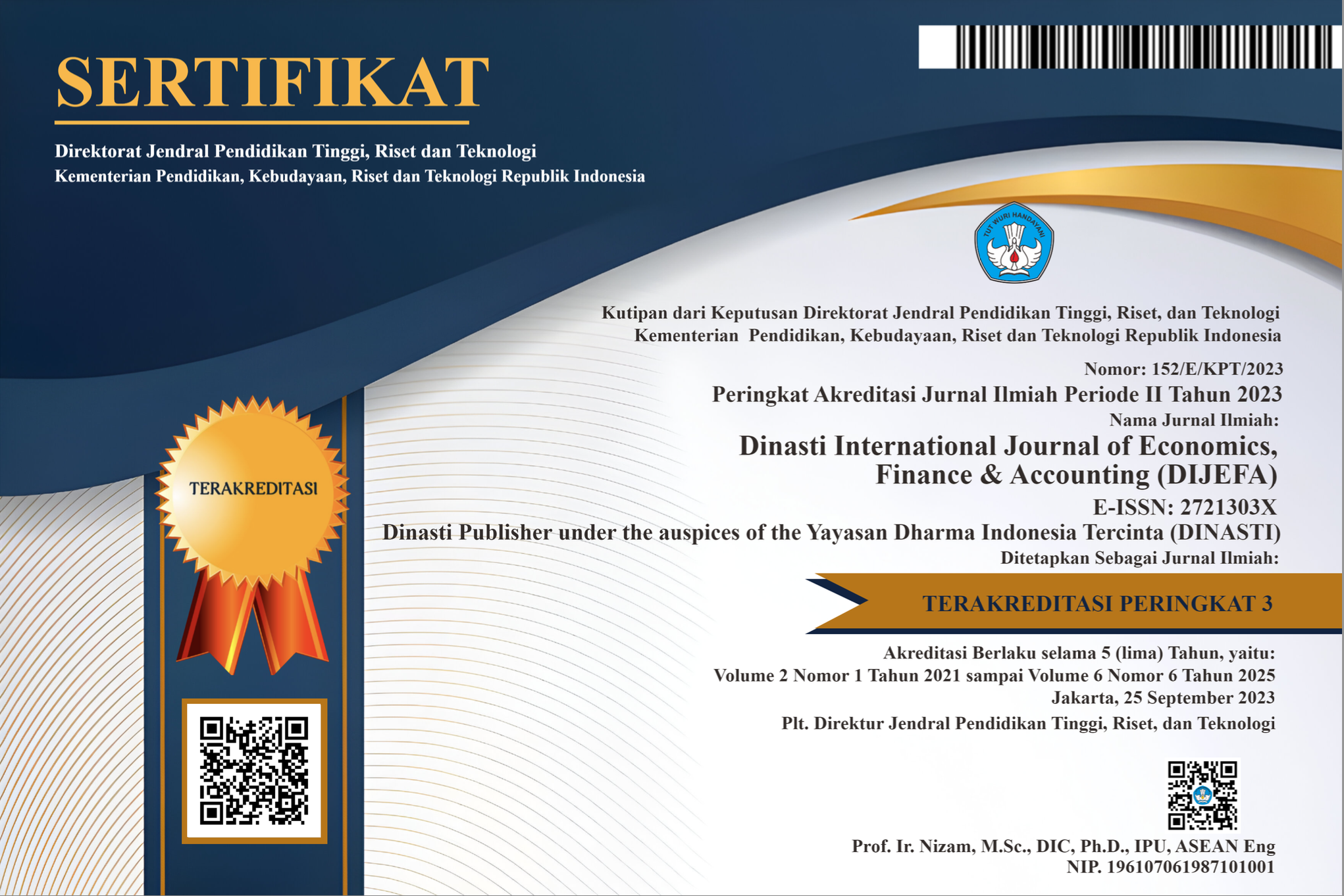The Influence of Transportation Management Systems and Supply Chain Integration on Business Performance with Supply Chain Performance as a Mediating Variable in the Automotive Industry in Indonesia
DOI:
https://doi.org/10.38035/dijefa.v5i6.4067Keywords:
Business Performance, Supply Chain Integration, Supply Chain Performance, & Transport Management SystemAbstract
The study explores the impact of Transportation Management Systems and supply chain integration on business performance in Indonesia's automotive industry, emphasizing how strong integration enhances operational efficiency and competitiveness. It aims to provide insights for company management, investors, regulators, and academicians, contributing to a deeper understanding of Supply Chain Management strategies and their effects on business outcomes. This study examines the impact of Transportation Management System (TMS) and supply chain integration (SCI) on business performance, mediated by supply chain performance (SCP), within the Automotive Industry in Indonesia, using a 5-point Likert scale questionnaire and validated indicators to ensure reliability and validity. The research found that Transportation Management System (TMS) has a positive and significant impact on business performance (BP), enhancing automotive companies' performance in Indonesia. Conversely, Supply Chain Integration (SCI) negatively affects business performance, suggesting that higher integration can reduce performance. However, when both TMS and SCI are mediated by supply chain performance (SCP), the results improve significantly, indicating that effective management of these variables can enhance company performance through better supply chain outcomes.
References
Ammad Zia ul Haq, (2022). Impact of Supply Chain Integration on Supply Chain Performance: Moderating Role of Supply Chain Flexibility. Journal of Management and Research (Volume 9, Issue 2, 2022), Terindeks : DOAJ (Directory of Open Access Journals). Doi: https://doi.org/10.32350/jmr.92.05
Bank Indonesia. (2024). Survei Kegiatan Dunia Usaha - Triwulan I 2024. Diakses dari https://www.bi.go.id/id/publikasi/laporan/Pages/SKDU-Triwulan-I-2024.aspx
Badan Pusat Statistik. (2024). Berita Resmi Statistik No. 84/11/Th.XXVII, 15 November 2024.
Barney, J. B. (1991). “Firm resources and sustained competitive advantage”,. Journal of Management, Vol. 17(1), 19–120.DOI: https://doi.org/10.1177/014920639101700108
Barney, J. B. (1 Wernerfelt. (1984). A resource-based view of the firm. Strategic Management Journal 5, 171-180. https://doi.org/10.1002/smj.4250050207
Barney, J. B. (2012). Purchasing, Supply Chain Management and Sustained Competitive Advantage: The Relevance of Resource-based Theory. Journal of Supply Chain Management, 48(2), 3–6. doi:10.1111/j.1745-493x.2012.03265.x
Chen, H., Daugherty, P. and Landry, T. (2009a). Supply chain process integration: A theoretical framework, Journal of Business Logistics, 30(2), pp27-46. DOI:10.1002/j.2158-1592.2009.tb00110.x
Chen, H., Daugherty, P. and Roath, A. (2009b). Defining and operationalising supply chain process integration, Journal of Business Logistics, 30(1), pp63-84. ttp://dx.doi.org/10.1002/j.2158-1592.2009.tb00099.x
Christopher, M., & Holweg, M. (2011). Supply chain 2.0: Managing supply chains in the era of turbulence. The International Journal of Physical Distribution and Logistics Management, 41 (1), 63–82. ISSN: 0960-0035.Doi: https://doi.org/10.1108/09600031111101439
Christopher, M., & Peck, H. (2004). Building the resilient supply chain. The international journal of logistics management, 15(2), 1-14. ISSN: 0957-4093. DOI : https://doi.org/10.1108/09574090410700275
Cristopher M, (2013). Logistic and supply chain management 4 th edition. New jersey: prentice hall.
Davenport, T H, and J D Brooks, (2024). “enterprise System and the supply chain.” Jurnal of enterprise information management 17 (1): 8-19.
Dyer, J. H., & Hatch, N. (2006). Relation-specific capabilities and barriers to knowledge transfers: Creating advantage through network relationships. Strategic Management Journal, 27, 701– 719. extensions. J. Oper. Manag. 30 (1), 99–115.DOI : http://dx.doi.org/10.1002/smj.543
Dyer, J. H., & Singh, H. (1998). The relational view: Cooperative strategy and sources of interorganizational competitive advantage. Academy of management review, 23(4), 660- 679. DOI : https://doi.org/10.2307/259056
Fabbe-Costes, N. and Jahre, M. (2008). Supply chain integration and performance: a review of the evidence, International Journal of Logistics Management, Vol. 19 No. 2, pp. 130-154. DOI: ttps://doi.org/10.1108/09574090810895933
Fabbe-Costes, N., & Jahre, M. (2007). Supply chain integration improves performance: The Emperor’s new suit? The International Journal of Physical Distribution and Logistics Management, 37 (10), 835–855. DOI:10.1108/09600030710848941
Gaikindo. (2024). Data Ekspor CBU Gaikindo Tahun 2023-2024. Diakses dari https://www.gaikindo.or.id
Gang Li (2020). The impact of supply chain relationship quality on knowledge sharing and innovation performance: evidence from Chinese manufacturing industry. Journal of Business & Industrial Marketing ISSN: 0885-8624. https://doi.org/10.1108/JBIM-02-2020-0109
Ghofar, A., Kundarto, M., Sugandini, D., Ekawati, T., & AMALLIA, B. A. (2020). PERSPEKTIF MANAJEMEN RANTAI PASOKAN: KAPABILITAS STRATEGIS. SBN 978-623-7707-87-5
Ghozali, I. (2018). Structural Equation Modeling Metode Alternatif dengan Partial Least Squares (PLS). Universitas Diponogoro: Semarang.
Ghozali, I., & Latan, H. (2015). Partial least squares konsep, teknik dan aplikasi menggunakan program smartpls 3.0 untuk penelitian empiris. Semarang: Badan Penerbit UNDIP.
G. Li, Shao, dan Zhang, A., Liu, H., & Gu, J. (2021). Linking business model design and operational performance: The mediating role of supply chain integration. Industrial Marketing Management, 96, 60-70. https://doi.org/https://doi.org/10.1016/j.indmarman.2021.04.009
Heidenreich, M. (2012). The social embeddedness of multinational companies: a literature review. Socio-Economic Review, 10(3), 549-579. DOI:10.1093/ser/mws010
Hunt, S. D., & Davis, D. F. (2008). Grounding supply chain management in resource?advantage theory. Journal of supply chain management, 44(1), 10-21. DOI:10.1111/j.1745-493X.2008.00042.x
J.E. Sutanto, et al (2023). The effect of supply chain organizational and supply agility on supply chain performance: The mediation role of supply chain strategy in retail shops. Uncertain Supply Chain Management. DOI : 0.5267/j.uscm.2022.11.002.
Justice Odei Som et al., 2019). The effect of Supply Chain Integration on Supply Chain Performance. Proceedings of the Ninth International Conference on Engaged Management Scholarship (2019), DOI : http://dx.doi.org/10.2139/ssrn.3468798
Kasilingam, R.G. (2010). Logistics and transportation. Great Britain: Kluwer Academic Publishers. DOI: https://doi.org/10.47672/ajscm.644
Kenyon, . N., & Meixell, M.J. (2011). Success Factors And Cost Management Strategies For Logistics Outsourcing. Journal Of Management & Marketing Research, 7, 1-17.
Kiraga, R. (2014). Transport management practices and logistics performance of humanitarian organizations in Kenya. unpublished MBA Project, University of Nairobi
Kozlenkova, I. V., Samaha, S. A., & Palmatier, R. W. (2014). Resource-based theory in marketing. Journal of the Academy of Marketing Science, 42(1), 1-21. DOI 10.1007/s11747-013-0336-7
Lee, S., & Kim, T. (2022). Innovations in Supply Chain Technology. International Journal of Operations Management, 28(3), 56-72.
Liu, A., Liu, H., & Gu, J. (2021). Linking business model design and operational performance: The mediating role of supply chain integration. Industrial Marketing Management, 96, 60-70. https://doi.org/https://doi.org/10.1016/j.indmarman.2021.04.009.
Liu, A., Liu, H., & Gu, J. (2021). Linking business model design and operational performance: The mediating role of supply chain integration. Industrial Marketing Management, 96, 60–70. https://doi.org/10.1016/j.indmarman.2021.04.009
Lin, D., Lee, C. K. M., Lau, H., & Yang, Y. (2018). Strategic response to Industry 4.0: an empirical investigation on the Chinese automotive industry. Industrial Management & Data Systems, 118(3), 589–605. https://doi.org/10.1108/IMDS-09-2017-0403
Liu, H., Wei, S., Ke, W., Wei, K. K., & Hua, Z. (2016). The configuration between supply chain integration and information technology competency: A resource orchestration perspective. Journal of Operations Management, 44(1), 13–29. https://doi.org/10.1016/j.jom.2016.03.009
Liu, H., Ke, W., Kee Wei, K., & Hua, Z. (2013). Effects of supply chain integration and market orientation on firm performance: Evidence from China.International Journal of Operations & Production Management, 33(3), 322-346. DOI:10.2139/ssrn.2442771
Liu, Y., Liang, L. (2015). Evaluating and developing resource-based operations strategy for competitive advantage: an exploratory study of Finnish high-tech manufacturing industries. Int. J. Prod. Res. 53 (4), 1019–1037. DOI: 10.1080/00207543.2014.932936
Mesquita, L. F., Anand, J., & Brush, T. H. (2008). Comparing the resource-based and relational views: Knowledge transfer and spillover in vertical alliances. Strategic Management Journal, 29, 913–941. DOI: 10.1002/smj.699
Miftakul Huda, (2022). Pengaruh Enterprise Resource Planning Terhadap Supply Chain Management dan Corporate Performance pada Perusahaan Korea Jababeka. Vol 14 No 1 (2022): JSMA (Jurnal Sains Manajemen dan Akuntansi) DOI: https://doi.org/10.37151/jsma.v14i1.86
Monika Kussetya Ciptani, et all. (2019). THE EFFECT OF SUPPLY CHAIN QUALITY INTEGRATION ON SUPPLY CHAIN MANAGEMENT PRACTICE TO ACHIEVE SUPPLY CHAIN PERFORMANCE. Journal of Applied Accounting and Finance (JAAF) Volume 3. DOI: http://dx.doi.org/10.33021/jaaf.v3i2.809
Mohammed Taj Hejazi, et all (2024). impact of green supply chain integration management on business performance: a mediating role of supply chain resilience and innovation the case of Saudi Arabian manufacturing sector. Cogent Business & Management. Vol 11 no 1. https://doi.org/10.1080/23311975.2024.2392256
Downloads
Published
How to Cite
Issue
Section
License
Copyright (c) 2025 Wahyu Nurmasari, Wahyuningsih Nurmasari, Triwulandari Satitidjati Dewayana, Faradisa Dewayana

This work is licensed under a Creative Commons Attribution 4.0 International License.
Authors who publish their manuscripts in this journal agree to the following conditions:
- The copyright on each article belongs to the author(s).
- The author acknowledges that the Dinasti International Journal of Economics, Finance & Accounting (DIJEFA) has the right to be the first to publish with a Creative Commons Attribution 4.0 International license (Attribution 4.0 International (CC BY 4.0).
- Authors can submit articles separately, arrange for the non-exclusive distribution of manuscripts that have been published in this journal into other versions (e.g., sent to the author's institutional repository, publication into books, etc.), by acknowledging that the manuscript has been published for the first time in the Dinasti International Journal of Economics, Finance & Accounting (DIJEFA).


























































